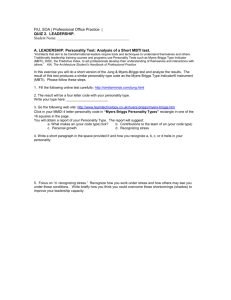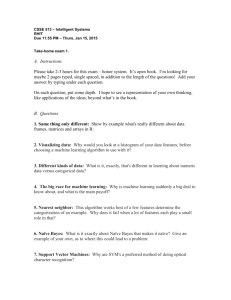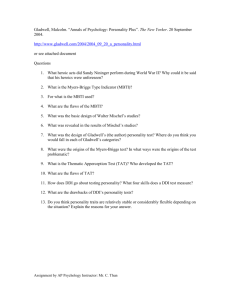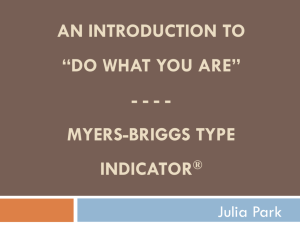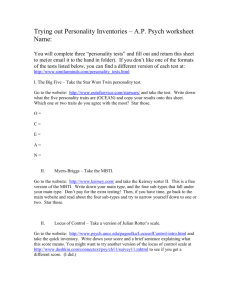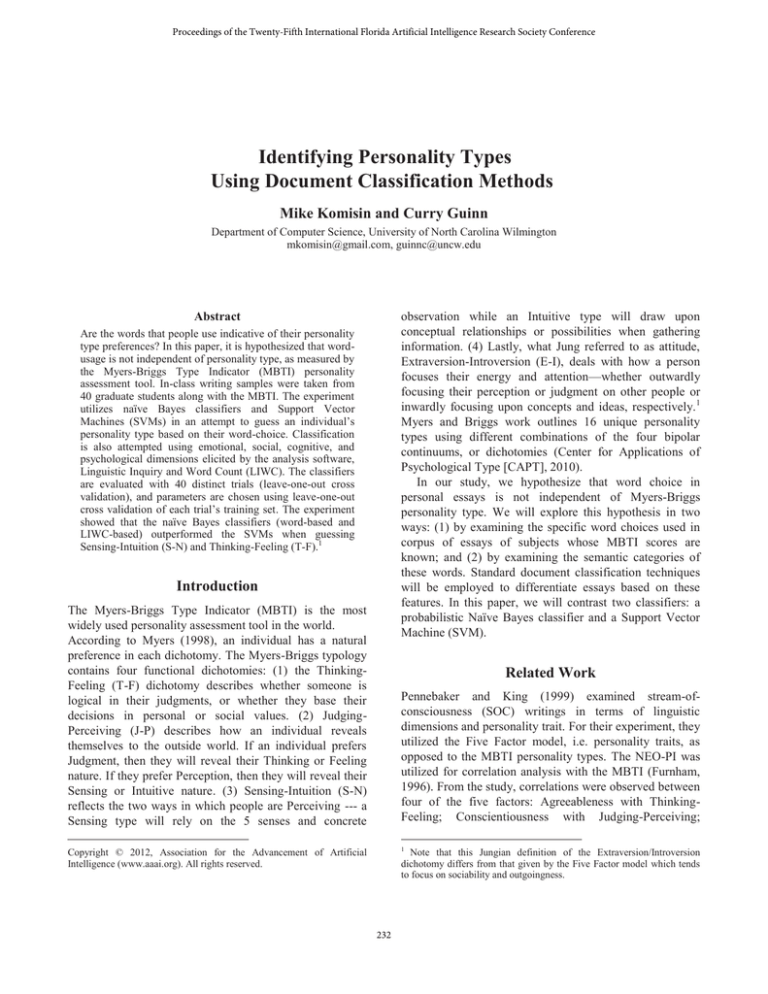
Proceedings of the Twenty-Fifth International Florida Artificial Intelligence Research Society Conference
Identifying Personality Types
Using Document Classification Methods
Mike Komisin and Curry Guinn
Department of Computer Science, University of North Carolina Wilmington
mkomisin@gmail.com, guinnc@uncw.edu
Abstract
observation while an Intuitive type will draw upon
conceptual relationships or possibilities when gathering
information. (4) Lastly, what Jung referred to as attitude,
Extraversion-Introversion (E-I), deals with how a person
focuses their energy and attention—whether outwardly
focusing their perception or judgment on other people or
inwardly focusing upon concepts and ideas, respectively. 1
Myers and Briggs work outlines 16 unique personality
types using different combinations of the four bipolar
continuums, or dichotomies (Center for Applications of
Psychological Type [CAPT], 2010).
In our study, we hypothesize that word choice in
personal essays is not independent of Myers-Briggs
personality type. We will explore this hypothesis in two
ways: (1) by examining the specific word choices used in
corpus of essays of subjects whose MBTI scores are
known; and (2) by examining the semantic categories of
these words. Standard document classification techniques
will be employed to differentiate essays based on these
features. In this paper, we will contrast two classifiers: a
probabilistic Naïve Bayes classifier and a Support Vector
Machine (SVM).
Are the words that people use indicative of their personality
type preferences? In this paper, it is hypothesized that wordusage is not independent of personality type, as measured by
the Myers-Briggs Type Indicator (MBTI) personality
assessment tool. In-class writing samples were taken from
40 graduate students along with the MBTI. The experiment
utilizes naïve Bayes classifiers and Support Vector
Machines (SVMs) in an attempt to guess an individual’s
personality type based on their word-choice. Classification
is also attempted using emotional, social, cognitive, and
psychological dimensions elicited by the analysis software,
Linguistic Inquiry and Word Count (LIWC). The classifiers
are evaluated with 40 distinct trials (leave-one-out cross
validation), and parameters are chosen using leave-one-out
cross validation of each trial’s training set. The experiment
showed that the naïve Bayes classifiers (word-based and
LIWC-based) outperformed the SVMs when guessing
Sensing-Intuition (S-N) and Thinking-Feeling (T-F).1
Introduction
The Myers-Briggs Type Indicator (MBTI) is the most
widely used personality assessment tool in the world.
According to Myers (1998), an individual has a natural
preference in each dichotomy. The Myers-Briggs typology
contains four functional dichotomies: (1) the ThinkingFeeling (T-F) dichotomy describes whether someone is
logical in their judgments, or whether they base their
decisions in personal or social values. (2) JudgingPerceiving (J-P) describes how an individual reveals
themselves to the outside world. If an individual prefers
Judgment, then they will reveal their Thinking or Feeling
nature. If they prefer Perception, then they will reveal their
Sensing or Intuitive nature. (3) Sensing-Intuition (S-N)
reflects the two ways in which people are Perceiving --- a
Sensing type will rely on the 5 senses and concrete
Related Work
Pennebaker and King (1999) examined stream-ofconsciousness (SOC) writings in terms of linguistic
dimensions and personality trait. For their experiment, they
utilized the Five Factor model, i.e. personality traits, as
opposed to the MBTI personality types. The NEO-PI was
utilized for correlation analysis with the MBTI (Furnham,
1996). From the study, correlations were observed between
four of the five factors: Agreeableness with ThinkingFeeling; Conscientiousness with Judging-Perceiving;
1
Copyright © 2012, Association for the Advancement of Artificial
Intelligence (www.aaai.org). All rights reserved.
Note that this Jungian definition of the Extraversion/Introversion
dichotomy differs from that given by the Five Factor model which tends
to focus on sociability and outgoingness.
232
comparison across the same 64 psychological and
contextual dimensions as the English LIWC.
Mairesse and Walker (2006) analyzed the same recorded
speech as Pennebaker and Mehl using the machinelearning algorithm, RankBoost. Their findings showed they
were able to successfully predict many of the Five Factor
traits of individuals using several feature sets including
LIWC, prosody (pitch, intensity, and speech rate), and with
features gathered using the MRC psycholinguistic
database.
Extraversion with Extraversion-Introversion; and Openness
with Sensing-Intuition. The dimension Neuroticism is not
correlated with any of the Myers-Briggs categories,
causing some criticism of the MBTI by McCrae and Costa
(1989). These relationships also add to the credibility of
the Myers-Briggs type theory in that both assessments are
reliable indicators of personal dimensions that do not
change much at all over time (Myers, 1998).
Pennebaker and King’s experiment shows statistically
significant correlation between four linguistic dimensions
and the Five Factor scores of the authors. The four
linguistic dimensions were derived by Pennebaker and
King (1999) using principal component analysis on the
Linguistic Inquiry and Word Count (LIWC) dimensions
from 838 stream-of consciousness (SOC) writing samples.
The four dimensions derived from the study were labeled:
Immediacy, Making Distinctions, The Social Past, and
Rationalization. Making Distinctions, for example, is a
dimension comprised of four LIWC text categories:
tentative (e.g. depends, guess, hopeful, luck), exclusive
(e.g. but, either, or), negation (e.g. can’t, hasn’t, neither,
not), and inclusive (e.g. and, with, both). Their work
highlights correlations between the LIWC categories and
the Five Factor scores for individuals. For example, three
categories in the Making Distinctions dimension (tentative,
exclusive, and negations) correlate negatively with
Extraversion on the Five Factor scores.
Chung and Pennebaker (2008) used the LIWC to
analyze self-descriptive essays. Through principle
component analysis using varimax rotation, they were able
to show that factor analysis on adjectives in the essays
produced 7 factors which they found to be statistically
significant indicators of the Big Five traits. Interestingly,
some of the factors were unipolar and some exhibited
bipolarity. Factors included 7 broadly labeled categories:
Social, Evaluation, Self-Acceptance, Negativity, Fitting In,
Psychological, Stability, and Maturity. The highest factor,
Sociability, included self-descriptive adjectives like quiet,
shy, outgoing, reserved, comfortable, open, friendly, and
insecure. One interesting point is that participants that used
words like shy, or quiet, were actually more likely to show
positive correlation with Extraversion in the Five Factor
scores. However, Pennebaker & King’s (1999) analysis of
stream-of-consciousness (SOC) writings suggested the
statistically significant positive correlation between the
LIWC Social category and Extraversion.
A Korean version of the Linguistic Inquiry and Word
Count (KLIWC) was used to analyze eighty stream-ofconsciousness writings with respect to Myers-Briggs and
the Five Factor model (Lee et al., 2007). Lee et al.
introduce correlations between the KLIWC and MyersBriggs types, but the focus of the study is primarily on
linguistic categories and does not provide a means of
Methodology
Data Collection
For our study, data was collected as part of a graduate
course on conflict management in which students took the
Myers-Briggs Type Indicator and completed a Best
Possible Future Self (BPFS) exercise. Over 3 semesters,
data was collected from 40 subjects.
Best Possible Future Self Writing (BPFS) Exercise
The Best Possible Future Self essay contains elements of
self-description, present and future, as well as various
contexts (e.g. work, school, family, finances). King’s
(2001) BPFS exercise is as follows:
Think about your life in the future. Imagine that
everything has gone as well as it possibly could. You
have worked hard and succeeded at accomplishing all
of your life goals. Think of this as the realization of all
of your life dreams. Now, write about what you
imagined (p. 801).
Word stemming
Word stemming is a simple way to reduce the feature set of
a corpus, and, in doing so, reduce the sparseness of the data
set. The simplest methods of word stemming use rulebased processes like dropping suffixes -e, -es, -ed, and ing. In computer literature, the most commonly used
stemming algorithm is Porter stemming (Porter, 1980). It is
a rule-based approach to suffix stripping. The Natural
Language Toolkit (Bird et al., 2009) provided an
implementation of the Porter stemmer used in our trials.
Stop-words
Stop-words are words which generally act as syntactic
sugar—for example, articles such as the, a, or an give little
insight into the content of a document but make the
meaning of content words more clear. Stop-word filtering
has become commonplace in natural language processing,
often improving the accuracy of word-based classifiers by
eliminating common words which offer less contextual
meaning. An English corpus of stop-words is included in
the Natural Language Toolkit (Bird et al. 2009).
233
Experimental Goals
In total, there are four MBTI personality type dichotomies:
Extroversion or Introversion (E-I), Sensing or Intuition (SN), Thinking or Feeling, Judging or Perceiving. Our
classification problem is a binary decision for each
dichotomy. Leave-one-out cross-validation is used as an
unbiased approach to model selection (Elisseeff & Pontil,
2003). Forty students were given the MBTI Step II with a
summary of these results given in Table 1. The MBTI
reports include a clarity index for each dichotomy. The
scale of these clarity scores range from 0 to 30. The clarity
score reflects the consistency of an individual to convey a
given preference within the questionnaire (Myers, 1998).
Thus, a low clarity score means that the assessment is less
clear, and a high clarity score denotes that the
questionnaire’s decision is very clear for a given
preference (see Table 2 for a representative sample). In one
experiment, clarity scores were used to select a subset of
participants for text classification. In another, we used the
entire set of subjects.
Smoothing
Data smoothing techniques account for terms in which a
previously unseen word is encountered in the test case. In
this study we tried a number of smoothing techniques
including Lidstone smoothing, Good-Turing smoothing,
and Witten and Bell Smoothing (Chen and Goodman,
1999).
Naïve Bayes
The naïve Bayes model utilizes a joint probability word
distribution with priors calculated from the training set.
Naïve Bayes accounts for prior probabilities of a class
when attempting to make a classification decision. It uses
what is referred to as the maximum a priori (MAP)
decision rule to classify unseen texts using the word
frequencies for each class’s bag-of-words. In the study,
each competing preference, e.g. Introversion vs.
Extraversion, has its own bag-of-words to help classify the
test documents. Leave-one-out cross validation is used to
test the precision and recall of the classifier.
Support Vector Machines
Support Vector Machines have their roots in binary linear
classifiers. Geometrically-based, they transform data into a
higher-dimensional space using a kernel function, then, use
a separating hyperplane to make a decision boundary. The
decision boundary allows for previously unseen samples to
be classified based on the hyperplane which separates
attributes according to their associated training labels
(Cortes & Vapnik, 1995).
Linguistic Inquiry and Word Count (LIWC)
The Linguistic Inquiry and Word Count program was used
to provide an alternative feature set to the word-frequency
set. LIWC processes multiple text files and returns a wordfrequency distribution based on well-defined categories,
e.g. money, social, positive, and negative. The LIWC
utilizes sixty-four psychological and social dimensions
which may overlap or aggregate. The hierarchy of
categories begins with four dimensions: linguistic,
psychological, relativity, and current concerns. These
dimensions are comprised of multiple categories, and
words may belong to more than one category.
MyersBriggs
Preferences
Est. Population
Distribution
Sample
Distribution
Extraversion
49.0%
65.0% (26)
Introversion
51.0%
35.0% (14)
Sensing
70.0%
52.5% (21)
Intuition
30.0%
47.5% (19)
Thinking
45.0%
47.5% (19)
Feeling
55.0%
52.5% (21)
Judging
58. 0%
60.0% (24)
Perceiving
43.0%
40.0% (16)
Table 1: Population and Sample Distributions by
Preference (sample counts in parentheses).
Personality
Type
E
ESFJ
24
ISTJ
ISTJ
Experiments
ENFP
The data was collected over three semesters in 2010 and
2011 as part of a course on conflict management offered to
graduate students. The data consists of two parts–the
Myers-Briggs Type Indicator Step II (MBTI) results and
the Best Possible Future Self (BPFS) essays. The MBTI
Step II gives a more detailed classification than the MBTI,
but only the primary dichotomies were utilized for
classification. The BPFS exercise was given first.
S
5
2
14
24
19
ESFJ
12
ENFP
25
ESTP
26
T
J
17
28
22
24
4
8
10
P
14
1
23
1
F
5
21
26
ENFJ
N
9
24
ISFJ
ISTP
I
18
8
1
4
17
4
21
10
18
5
11
30
13
18
6
Table 2: Sample MBTI scores of some participants.
234
The Best Possible Future Self essays were categorized
based on the corresponding MBTI score and a summary
of the token and unique word count is presented in Table
3. WPD is words tokens per document; WTD is unique
word types per document.
Myers-Briggs
Dichotomy
Word
Tokens
Unique
Words
Avg.
WPD
Avg.
WTD
Extraversion
10428
1859
401
72
Introversion
5275
1140
377
81
Sensing
7913
1455
377
69
Intuition
7790
1594
410
84
Thinking
6879
1348
362
71
Feeling
8824
1685
420
80
Judging
6210
1389
388
87
Perceiving
9493
1649
396
69
Preliminary analysis also revealed that for our dataset,
Lidstone smoothing performed better than either WittenBell or Good-Turing smoothing. Two trials are conducted
for each classifier, one using the entire dataset and one
using the subset based on highest clarity scores (the top
75th percentile of samples ordered by clarity score for each
dichotomy).
Word-based Naïve Bayes Classification Results
First, an analysis was conducted using simple Bayesian
statistics gathered for the words present in the training
corpus and tested using leave-one-out cross validation. The
results are presented in Figure 1. Precision and recall
scores were near 70% for Sensing (S) and Intuitive (N)
types. We then sampled from our corpus only data whose
MBTI clarity scores were in the top 75 th percentile of the
sample. Figure 2 is a presentation of the results of using a
Naïve Bayes classifier on that reduced dataset. By
eliminating the data with low clarity, the results are much
better with higher precision and recall scores for three
dichotomies: Sensing/Intuitive, Thinking/Feeling, and
Judging/Perceiving.
Table 3: Text features of BPFS essays.
Myers-Briggs
Dichotomy
Word
Tokens
Unique
Words
Avg.
WPD
Avg.
WTD
Extraversion
5631
1376
217
53
Introversion
2834
846
202
60
Sensing
4335
1067
206
51
Intuition
4130
1178
217
62
Thinking
3718
1015
196
53
100%
80%
60%
40%
20%
0%
Feeling
4747
1224
226
58
Recall
Judging
3312
1030
207
64
Precision 0.54 0.08 0.71 0.68 0.50 0.55 0.65 0.47
Perceiving
5153
1207
215
50
Table 4: Text features of BPFS essays after Porter
stemming and stop-word filtering.
E
I
S
N
T
F
J
P
0.58 0.07 0.71 0.68 0.53 0.52 0.63 0.50
Figure 1: Word-based classification results using naïve
Bayes with leave-one-out cross validation over entire
data set with sample size, n = 40.
Word-based Naïve Bayes Classification
The naïve Bayes classifier utilizes a bag-of-words input
space, i.e. a count of the token occurrences for each given
training set. Each preference is tested and represented
using a bag-of-words. For example, Extraversion and
Introversion will each be assigned a bag-of-words and be
pitted against one another using the MAP decision rule.
The term occurrences of the training set data are used to
calculate the conditional probabilities of the word types,
given their labeling. The distribution of prior probabilities
(i.e. the probability that an arbitrary document belongs to a
given class) will be calculated from the training data, as
well. Preliminary analysis revealed there were no
significant differences in classification when using the data
set of words prior to Porter stemming and stop-word
filtering versus the data set after those filters. Therefore, to
reduce the feature space we did employ both filters.
100%
80%
60%
40%
20%
0%
Recall
E
I
S
N
T
F
J
P
0.50 0.09 0.81 0.73 0.73 0.75 0.89 0.67
Precision 0.50 0.09 0.76 0.79 0.73 0.75 0.80 0.80
Figure 2: Word-based classification results using naïve
Bayes with leave-one-out cross validation over reduced
data set based on clarity scores with sample size, n = 30.
235
LIWC-based naïve Bayes Classification Results
Our next hypothesis was to test whether the semantic
categories of the words, as specified by the LIWC
database, would also provide the ability to predict MBTI
personality type. Using a similar methodology applied to
individual words, we used the word categories (e.g.,
positive emotion, work, money, family). Again, we used
the full dataset with leave-one-out testing, and then used a
modified dataset with 25% of the data removed with the
lowest clarity scores. The results of this experiment are
presented in Figure 3 and Figure 4. The precision and
recall rates are not as strong compared with the use of
stemmed word tokens in a naïve Bayes classifier.
120%
100%
80%
60%
40%
20%
0%
Recall
clarity scores. We only present the results from the reduced
dataset (Figure 5 and Figure 6) because the performance
was significantly worse than using the Naïve Bayes
approach. The combination of the large feature space of the
words appearing in each dichotomy and the small training
set resulted in very poor performance of the word-based
classification problem. Also, the SVM classifiers were
vulnerable to the unbalanced training sets (i.e., the
Introversion/Extroversion set and the Judging/Perceiving
set) – a known problem with SVMs. The SVM
performance using the LIWC features (a smaller feature
space than the number of unique words) was somewhat
better. In future experiments, we plan to use alternative
classifiers and a larger corpus.
100%
80%
60%
40%
20%
E
I
S
N
T
F
P
J
0%
0.92 0.07 0.52 0.63 0.58 0.52 0.06 0.96
Recall
Precision 0.65 0.33 0.61 0.55 0.52 0.58 0.50 0.61
E
I
S
N
T
F
J
P
1.00 0.00 0.31 0.60 0.20 0.50 0.94 0.25
Precision 0.65 0.00 0.45 0.45 0.27 0.40 0.64 0.75
Figure 3: LIWC-based classification results using naïve
Bayes with leave-one-out cross validation over entire
data set with sample size, n = 40.
100%
80%
60%
40%
20%
0%
Recall
Figure 5: LIWC-based classification results using SVM
with leave-one-out cross validation over reduced data
set based on clarity scores with sample size, n = 30.
100%
80%
60%
40%
E
I
S
N
T
F
P
20%
J
0%
0.95 0.00 0.56 0.73 0.60 0.50 0.08 0.83
Precision 0.63 0.00 0.69 0.61 0.53 0.57 0.25 0.58
Recall
E
I
S
N
T
F
J
P
0.85 0.36 0.63 0.47 0.47 0.56 0.88 0.00
Precision 0.71 0.57 0.56 0.54 0.50 0.53 0.56 0.00
Figure 4: LIWC-based classification results using naïve
Bayes with leave-one-out cross validation over reduced
data set based on clarity scores with sample size, n = 30.
Figure 6: LIWC-based classification results using naïve
Bayes with leave-one-out cross validation over reduced
data set based on clarity scores with sample size, n = 30.
SVM Classification Results
Our next experiment was to determine whether a nonlinear classifier might perform better than the stochastic
Bayesian classifier. Two support vector machine classifiers
were used: one using the individual words as features and
the other classifier using LIWC word categories as
features. As in the previous experiments, we looked at the
full dataset and the reduced dataset with the 75% highest
236
useful classifier with our dataset. Both the
Extrovert/Introvert set and the Judging/Perceiving set were
unbalanced. SVMs are known to be vulnerable to training
errors when presented with unbalanced datasets. Other
researchers suggest that the poor performance of the SVMs
could be attributed to the sparseness of a data set relative to
a large number of features (Ng & Jordan, 2002). Thus, if
SVMs generally perform better on densely populated data
sets, a possible indication of such an attribute is the more
balanced performance during LIWC-based SVM
classification compared with word-based SVM trials. In
our future work, we will examine Random Forest
classifiers, which may perform better given the constraints
of our dataset.
% Correct
0.8
0.6
0.4
E, I
0.2
S, N
SVM
LIWC-based
Word-based
Word-based
LIWC-based
Majority
0.0
T, F
J, P
Naïve Bayes
Figure 7: Summary of results with leave-one-out cross
validation and sample size, n = 40
References
Bird, S., Klein, E. & Loper, E. (2009). Natural Language
Processing with Python – Analyzing Text with the Natural
Language Toolkit. O’Reilly Media.
Center for Applications of Psychological Type [CAPT]. (2010).
Jung's theory of psychological types and the MBTI® instrument.
Retrieved from http://www.capt.org/take-mbti-assessment/mbtioverview htm
Chen, S. F. & Goodman, J. (1999). An empirical study of
smoothing techniques for language modeling. Computer Speech
& Language, 13.4, 359-93.Chung, C.K. & Pennebaker, J.W.
(2008). Revealing dimensions of thinking in open-ended selfdescriptions: An automated meaning extraction method for
natural language. Journal of Research in Personality, 42.1, 96132.
Cortes, C. & Vapnik, V. (1995). Support-vector networks.
Machine Learning, 20.3, 273-97.
Elisseeff, A. & Pontil, M. (2003). Leave-one-out error and
stability of learning algorithms with applications. Learning
Theory and Practice. IOS Press.
Furnham, A. 1996. The big five versus the big four : The
relationship between the Myers-Briggs Type Indicator (MBTI)
and NEO-PI five factor model of personality. Personality and
Individual Differences 21 :303 - 307.
King, L. A. (2001). The health benefits of writing about life
goals. Personality and Social Psychology Bulletin, 27.7, 798-807.
Lee, C., Kim, K., Seo, Y., & Chung, C. (2007). The relations
between personality and language use. The Journal of General
Psychology, 134.4, 405-13
Mairesse, F., Walker, M. (2006) Automatic Recognition of
Personality in Conversation. In Proceedings of HLT-NAACL
2006, New York City, June 2006.
Myers, I. (1998). MBTI Manual: A guide to the development and
use of the Myers-Briggs Type Indicator. Palo Alto, CA:
Consulting Psychologists.
Pennebaker, J. W. & King, L. A. (1999). Linguistic styles:
Language use as an individual difference. Journal of Personality
and Social Psychology, 77.6, 1296-312.
Porter, M.F. (1980). An algorithm for suffix stripping, Program,
14.3, 130–137.
% Correct
1.0
0.8
0.6
0.4
E, I
0.2
S, N
SVM
LIWC-based
Word-based
Word-based
LIWC-based
Majority
0.0
T, F
J, P
Naïve Bayes
Figure 8: Summary of results with leave-one-out cross
validation and reduced sample size, n = 30; lowest
clarity scores removed
Conclusions
Figure 7 and Figure 8 summarize the results of our trials.
Using a relatively small dataset and leave-one-out crossvalidation, a Naïve Bayes classifier using a bag-of-words
approach was able to predict three of the Myers-Briggs
personality dichotomies with substantially higher precision
and recall than those obtained using a simple majority
discussion. The dichotomies of Sensing/Intuitive and
Thinking/Feeling were predicted with precision and recall
above 75% when using the dataset with the top 75% of
clarity scores. The Judging/Perceiving category was
predicted with higher precision but slightly lower recall
rates. Using LIWC features resulted in less successful
predictions although the Sensing/Intuitive dichotomy was
moderately distinguishable. SVMs did not prove to be a
237

